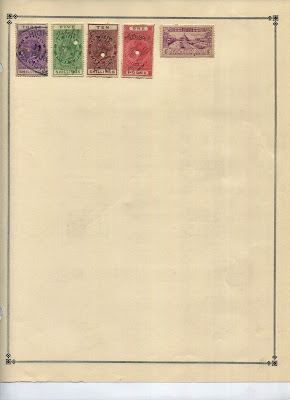Great idea!
With the high hopes of a kid exploring trunks in
grandma’s attic, I rushed to reassess my New Zealands (all scanned, see below).
Can you spot the treasure? No?
Well, neither could I.
Interesting stamps, yes. A pile of gold, no.
So, I’ll write about the ordinaries, and nothing in
classic New Zealand philately is more ordinary than the lowly Penny Universal
postage stamp. Every ragtag album has them, often many of them, some bright
carmine, some faded from too much wear. Dealers can’t sell them even for
pennies.
The Penny Universal comes in three similar designs and
a host of different shades, papers, watermarks and perforations (including
tractor feed holes for vending machines). Scott’s catalog lists 15 of these
variations while Stanley Gibbons, an ever more meticulous British catalog,
counts 105. In addition, Penny Universals were overprinted to make NZ official
stamps and commemoratives. Outlying islands – Niue, Samoa, Cook (Rarotonga) – used
overprints of Penny Universals. Does anyone have all, or even most, of these? This
is serious specialist territory.
Aitutaki has three different overprints on Penny
Universals, all afforded spaces in Big Blue.
There’s even a book about this one stamp’s variations:
Some variations list for over £1500,
a small pile of gold. A few are unique, or nearly so, and command even higher
prices if/when they’re available. Upon learning this, I got out my magnifying
loop and continued to look. I might find variations for which wacky specialists
would pay fortunes.
The first Penny Universal was released on New Year’s
Day, 1901. It features Zealandia, the female personification of New Zealand.
Scott’s catalog lists her as name as Commerce, although many Kiwis beg to
differ. She does have a rather different appearance on the 1911 Coat of Arms
(top, left) – hair done up, slimmer. Moreover, in the stamp she wields a caduceus,
the classic symbol for protectors of thieves, merchants and messengers. So
maybe Scott is right.
The second design (1908) differs from the first in that the globe has slanted shading and the waves are not as high on the steamer’s bow. The third design (1909) has “Universal Postage” on a scroll and “Dominion of” inscribed at the top. Inattentive dealers regularly mislabel the three designs
A universal postage rate was a bold idea – one penny
to send a message anywhere in the world. The Postmaster General Joseph Ward (later
Prime Minister) had hoped the idea would encourage other nations to follow New
Zealand’s lead, thereby facilitating better international communication. Few
did. They feared loss of revenue if they complied. Some even refused to accept
mail with Universal stamps, notably the USA, France, Germany and neighboring
Australia. The latter’s refusal must have been a great disappointment to Ward.
New Zealand persisted, however, and in a relatively
short time increased sales of stamps more than made up for losses from the rate
reduction. The postcard (below), recently added to my collection, provides an
interesting example. Franked with Scott #129, it was mailed nine years after
the first universal stamp was issued. It travelled for a month and ten days
from Blenheim, NZ, to Northampton, England, then on to North Malvern. All for
one penny. At the time, the rate for sending a letter from Northampton to
Malvern, a distance of 60 miles by train, was one penny.
Of course, many valuable NZ stamps precede the
Zealandias and I am sorting through them for the promised pile of gold –
especially those issued in the 1850s (see supplement page, top line).
In the early years Māori runners carried some of the
mail despite frequent conflicts between the Māori and the European settlers.
Maybe some of the earlier stamps in our NZ collections came from letters
delivered by Māori mailmen. A 1955 centennial commemorative of NZ stamps, Scott
#302, features such a runner. I’ve always liked this stamp even though the
background seems to seep through the runner’s legs in many examples. Critics
have complained that #302 is overly romanticized and that Māori runners often
fared rather poorly. A more realistic image can be found online at https://teara.govt.nz/mi/1966/24331/an-early-maori-mail-runner.
Census: 147in BB spaces, 15 tip-ins, 94 on supplement
pages.







































I really enjoyed the post for New Zealand, especially the examples of the various penny universal overprints. I was surprised by the list of non-acceptance locations for the penny universal stamps from New Zealand. Its plan definitely would have enhanced worldwide communications.
ReplyDeleteI suppose that larger nations wondered why little New Zealand was bold enough to implement such a bold policy.
ReplyDelete